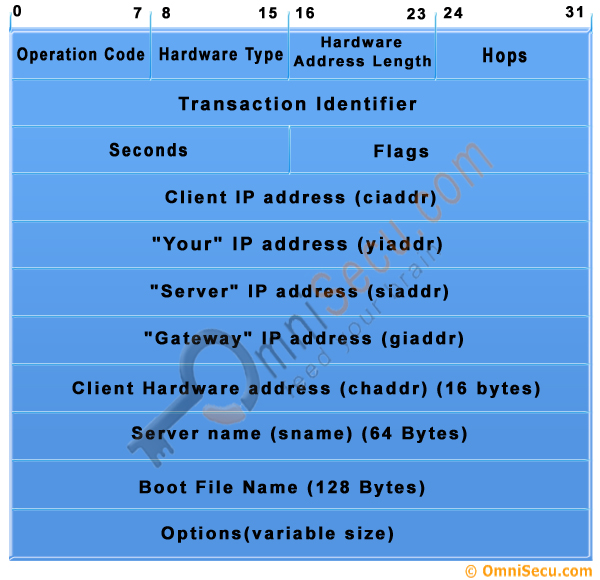Dynamic Host Configuration Protocol (DHCP) Message Format
Dynamic Host Configuration Protocol (DHCP) clients and Dynamic Host Configuration Protocol (DHCP) servers communicate by exchanging messages as discussed in previous lesson. All DHCP messages share a common format, as shown below. Dynamic Host Configuration Protocol (DHCP) was developed from BOOTP (RFC 951) and uses a message format that is based on the BOOTP specification since Dynamic Host Configuration Protocol (DHCP) shares UDP port numbers 67 and 68 with BOOTP. DHCP messages include a special option in the option field that differentiates them from BOOTP messages. DHCP a BOOTP uses UDP as the transport layer protocol, which provide no reliablity. Dynamic Host Configuration Protocol (DHCP) clients should retransmit the message when a responce is not received from the Dynamic Host Configuration Protocol (DHCP) server. For example, if no Dynamic Host Configuration Protocol (DHCP) servers respond to the DHCPREQUEST, the client continues to broadcast up to four times at 2, 4, 8, and 16 seconds. If a response is not received during this time, the client continues to broadcast every five minutes.
Dynamic Host Configuration Protocol (DHCP) Message Format
All Dynamic Host Configuration Protocol (DHCP) messages include a FIXED format section and a VARIABLE format section. The fixed format section consists of several fields that are the same in every Dynamic Host Configuration Protocol (DHCP) message. The variable format section in the Dynamic Host Configuration Protocol (DHCP) contains "OPTIONS", which carry additional configuration parameters.

Dynamic Host Configuration Protocol (DHCP) Message Format
| DHCP Message Field | Description |
|---|---|
| Operation Code | Specifies the type of the Dynamic Host Configuration Protocol (DHCP) message. Set to 1 in messages sent by a client (requests) and 2 in messages sent by a server (response). |
| Hardware Type | Specifies the network LAN architecture. For example, the ethernet type is specified when htype is set to 1. |
| Hardware Address Length | Layer 2 (Data-link layer) address length (MAC address) (in bytes); defines the length of hardware address in the chaddr field. For Ethernet (Most widely used LAN Standard), this value is 6. |
| Hops | Number of relay agents that have forwarded this message. |
| Transaction identifier | Used by clients to match responses from servers with previously transmitted requests. |
| seconds | Elapsed time (in seconds) since the client began theDynamic Host Configuration Protocol (DHCP) process. |
| Flags | Flags field is called the broadcast bit, can be set to 1 to indicate that messages to the client must be broadcast |
| ciaddr | Client's IP address; set by the client when the client has confirmed that its IP address is valid. |
| yiaddr | Client's IP address; set by the server to inform the client of the client's IP address. |
| siaddr | IP address of the next server for the client to use in the configuration process (for example, the server to contact for TFTP download of an operating system kernel). |
| giaddr | Relay agent (gateway) IP address; filled in by the relay agent with the address of the interface through which Dynamic Host Configuration Protocol (DHCP) message was received. |
| chaddr | Client's hardware address (Layer 2 address). |
| sname | Name of the next server for client to use in the configuration process. |
| file | Name of the file for the client to request from the next server (for example the name of the file that contains the operating system for this client). |
You have learned Dynamic Host Configuration Protocol (DHCP) Message Format and Dynamic Host Configuration Protocol (DHCP) Message fields in this lesson. Click "Next" to continue.